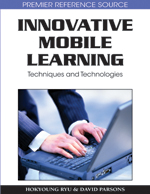Innovative Mobile LearningTechniques and Technologies
|

|
 Diese Seite wurde seit 1 Jahr inhaltlich nicht mehr aktualisiert.
Unter Umständen ist sie nicht mehr aktuell.
Diese Seite wurde seit 1 Jahr inhaltlich nicht mehr aktualisiert.
Unter Umständen ist sie nicht mehr aktuell.
 Zusammenfassungen
Zusammenfassungen
 Academia and industry have only begun to explore the vast capabilities that the emerging field of mobile learning has to enrich education. To help researchers and practitioners drive the realization of the potential benefits of mobile learning technology to the next level, a thorough survey of the state of knowledge in this ascending field is vital.
Academia and industry have only begun to explore the vast capabilities that the emerging field of mobile learning has to enrich education. To help researchers and practitioners drive the realization of the potential benefits of mobile learning technology to the next level, a thorough survey of the state of knowledge in this ascending field is vital.
Innovative Mobile Learning: Techniques and Technologies is the first book to comprehensively set out opportunities presented by mobile learning technologies, collecting incisive research articles from leading international experts. Covering field challenges, practical experiences, and current technological advances, this unique contribution to the current research will benefit academics and students in a variety of education and technology-related disciplines, as well as industry specialists in the field mobile technology.
 Kapitel
Kapitel 
- Designing Learning Activities with Mobile Technologies (Seite 1 - 20)


- Transforming the Practice of Mobile Learning - Promoting Pedagogical Innovation through Educational Principles and Strategies that Work
(Seite 21 - 46) (Patrick Danaher, Raj Gururajan, Abdul Hafeez-Baig)


- Understanding the Value of Interactive SMS for Large Classes (Seite 48 - 59) (Eusebio Scornavacca, Sid Huff, Stephen Marshall)


- Learning by Pervasive Gaming - An Empirical Study
(Seite 60 - 82) (Christian Kittl, Francika Edegger, Otto Petrovic)


- iPods as Mobile Multimedia Learning Environments - Individual Differences and Instructional Design
(Seite 83 - 101) (Peter E. Doolittle, Danielle L. Lusk, C. Noel Byrd, Gina J. Mariano)


- From Individual Learning to Collaborative Learning— Location, Fun, and Games - Place, Context, and Identity in Mobile Learning
(Seite 102 - 121) (Martin Owen)


- Collaborative Technology Impacts in Distributed Learning Environments (Seite 123 - 144) (Martha Grabowski, Greg Lepak)


- Constructing Mobile Technology-Enabled Environments for an Integrated Learning Approach (Seite 145 - 171) (María Felisa Verdejo, Carlos Celorrio, Emilio Julio Lorenzo, Marta Millán, Sergio Prades, Javier Vélez)


- Collaboration in Context as a Framework for Designing Innovative Mobile Learning Activities (Seite 172 - 196) (Daniel Spikol, Arianit Kurti, Marcelo Milrad)


- Participatory Simulation for Collaborative Learning Experiences (Seite 197 - 214) (Chengjiu Yin, Hiroaki Ogata, Yoneo Yano)


- Situated Learning with SketchMap (Seite 216 - 231) (Sosuke Miura, Pamela Ravasio, Masanori Sugimoto)


- An Architecture for a Personalized Mobile Environment to Facilitate Contextual Lifelong Learning (Seite 232 - 254) (Dionisios N. Dimakopoulos, George D. Magoulas)


- Designing Situated Learning Experiences (Seite 255 - 272) (Hokyoung Ryu)


- Developing a Mobile Learning Platform for a Professional Environment (Seite 273 - 300) (Ana Dzartevska)


- Handheld Educational Applications - A Review of the Research
(Seite 302 - 323) (Yanjie Song) (2009)


- Assessing the Benefits of AJAX in Mobile Learning Systems Design (Seite 324 - 355) (Feng Xie, David Parsons)


 Dieses Buch erwähnt ...
Dieses Buch erwähnt ...
 Dieses Buch erwähnt vermutlich nicht ...
Dieses Buch erwähnt vermutlich nicht ... 
 Nicht erwähnte Begriffe | cognitive apprenticeship |
 Tagcloud
Tagcloud
 Volltext dieses Dokuments
Volltext dieses Dokuments
 Bibliographisches
Bibliographisches 
 Beat und dieses Buch
Beat und dieses Buch
Beat hat dieses Buch während seiner Zeit am Institut für Medien und Schule (IMS) ins Biblionetz aufgenommen. Beat besitzt kein physisches, aber ein digitales Exemplar. Eine digitale Version ist auf dem Internet verfügbar (s.o.).









 Lernen
Lernen mobile learning
mobile learning , 971 kByte;
, 971 kByte;  Link unterbrochen? Letzte Überprüfung: 2021-03-21 Letzte erfolgreiche Überprüfung: 2015-02-28)
Link unterbrochen? Letzte Überprüfung: 2021-03-21 Letzte erfolgreiche Überprüfung: 2015-02-28) 

 Biblionetz-History
Biblionetz-History